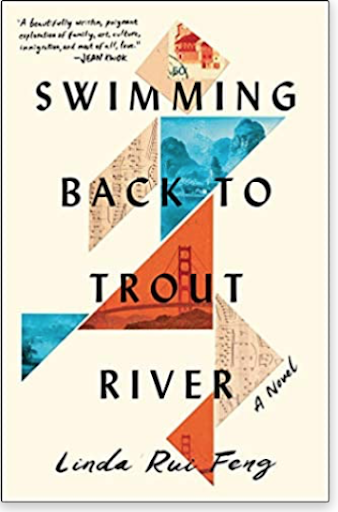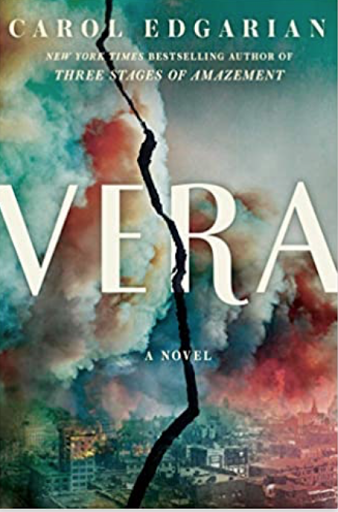
Recent Reviews

Swimming Back to Trout River by Linda Rui Feng
This review was published in the San Francisco Examiner on July 29, 2021
Linda Rui Feng’s debut novel “Swimming Back to Trout River” is an exquisite meditation on love and loss in the wake of China’s ruinous Cultural Revolution from 1966 to 1976. The book brings to life how repressive regimes create lasting emotional scars on individuals touched by their cruelties. The protagonists are vulnerable but resilient as they leave China to start anew in America. Their hopeful moments are few and fleeting as the wounds of the old world shape their choices in the new.
Feng, a former San Francisco resident and professor in East Asian studies at the University of Toronto, has written a book that’s not primarily about China’s politics. Instead, it is an evocative exploration of the inner life of specific immigrants and the burdens they carry with them.
The story begins in China in 1981 as Cassia, a young mother, abandons her 5-year-old daughter Junie at the home of her in-laws. The story of why Cassia leaves Junie unfolds slowly. Junie’s grandparents live in a small village, near a river, where they dote on Junie. Born without legs below her knees, Junie is not deterred by her disability. She is bright, inquisitive and loves her grandparents.
As Junie’s 12th birthday approaches, Junie’s father Momo, who is in the United States pursuing a graduate degree, writes that he will bring her to America to join him and Cassia. What Junie and her grandparents do not know is that when Cassia arrived in San Francisco, she did not proceed with her plan to meet Momo. She works as a nanny for a little boy, while Momo, many miles away, still hopes to reunite with Cassia and Junie.
Cassia and Momo met while working in a factory town in remote China. Both were traumatized by horrifying events during the Cultural Revolution; each witnessed terrifying acts of physical violence and emotional cruelty. Memories of the period remained too raw for them to share, and their emotional distance compounded over time. The birth of their disabled daughter exacerbated their separateness. Each reacted differently to her arrival. A subsequent and tragic life-changing event fueled their growing isolation.
As the story develops, it becomes apparent that although they left China, Momo and Cassia did not leave their personal demons behind. Their interior lives remain bound up in the anguish of their younger selves. By the end of the novel, we learn the secrets that haunt their lives. The narration artfully moves between past and present while the characters’ emotional complexity deepens.
A separate stream in the narrative revolves around Dawn, whom Momo met at university before knowing Cassia. A gifted musician, Dawn makes a mark in Momo’s life, inspiring his lifelong passion for music. Dawn, too, endured tragedy during the Cultural Revolution. While in San Francisco as part of a musical delegation from China, Dawn made the difficult decision to defect. Music’s ability to motivate, nurture and touch human souls is a prominent theme in the story.
Another powerful theme focuses on the Chinese word yuanfen, for which there is no English translation. The concept refers to the idea that invisible threads, which can be identified but not completely understood, connect people and events. Numerous examples of yuanfen create drama and tension as the novel crescendos toward its surprising conclusion.
I might have preferred a different ending, but this quibble doesn’t detract from the book’s extraordinary virtues. Feng, a gifted writer and storyteller, astutely and unusually conveys the role of emotions in determining life choices. “Swimming Back to Trout River” celebrates the power of hope, the interconnectedness of people, the constancy of grief and the complexity of love: together, a microcosm of the human condition.

Vera by Carol Edgarian
This review was published in the San Francisco Examiner on June 27, 2021 https://www.sfexaminer.com/entertainment/to-find-out-what-life-in-sf-was-like-after-the-1906-quake-read-vera/
For less than one minute on the morning of April 18th, 1906, San Francisco was shaken to its core. Buildings crumbled, fires raged and most of downtown San Francisco was destroyed. Carol Edgarian’s recent novel ‘Vera’ allows us to visit that time and place. Blending history with a coming-of-age story, this immersive novel chronicles the ’06 earthquake and its aftershocks. By the book’s end, we come to admire both Vera, the eponymous protagonist, and the citizens of San Francisco for their gritty resiliency in the quake’s aftermath.
We meet Vera in the first two pages. Now more than a hundred years old, she recalls how the quake changed her life. She begins her story on her fifteenth birthday, nine days before the earthquake. Vera is looking forward to seeing her mother, Rose, with whom she does not live. Rose is a famous San Francisco madam who operates a bordello in the bawdy Barbary Coast. When Vera was a toddler, Rose had arranged for Vera to be raised by a widow named Elsa Johnson. In return, Rose pays the household expenses for Elsa and her daughter Piper.
Minutes after the shaking stops on April 18th, further waves of catastrophe shatter the City. Elsa Johnson is crushed to death by a falling wall while Vera and Piper escape encroaching fires. The narration includes intricate details of how Vera and Piper survive those next few harrowing days. The City’s infrastructure has been decimated. Gas and electric lines are broken, water cisterns are cracked, and fires threaten almost every City block. A parade of evacuees flees from downtown to the western part of the City, where refugee camps are eventually established at Golden Gate Park, the Presidio and Lafayette Square. San Francisco looks like a war zone.
Vera eventually rescues her biological mother, Rose, under a pile of rubble in her Barbary Coast bordello and arranges for her to be transported to a hospital. Soon Vera is taking care of Rose while trying to understand her enigmatic and remote mother. Vera grows up quickly and joins forces with one of her mother’s loyal employees, a Chinese man named Tan. Like the City, Vera is determined and tenacious to move forward. As San Franciscans abandon social norms to focus on survival, Vera begins to imagine a different life for herself. She encounters looters and luminaries, heroes and hucksters as she learns to navigate this troubled world. With ease, Edgarian weaves historical characters into the story. Earlier in 1906, San Francisco Mayor Eugene Schmitz had been facing charges of bribery and extortion. Due to the upheaval, the indictment is delayed. Vera and Piper are friends with the Mayor’s daughter, and thus, readers are given a more personal perspective of this famous scandal.
Vera’s coming-of-age story was less compelling to this reader than the historical narrative. I struggled with Vera’s voice when her interactions with adults seemed implausible. Nonetheless, in terms of historical fiction, Edgarian succeeds. Her meticulous research is impressive. She includes countless facts, both large and small, about the quake’s effects on the City’s political, military, architectural and financial life.
In 1989 San Francisco suffered another tragic tremor. Both ’06 and ’89 were seismic events that linger in the foggy mist of the City’s collective memory. A wary acceptance of the possibility of another quake remains part of San Francisco’s ethos. ‘Vera’ is a reverent ode to the resiliency of San Francisco and her people. If you wonder what it might have felt like to be in the 1906 earthquake, ‘Vera’ is a great place to start.

When the Stars Go Dark by Paula McLain
This review was published in the San Francisco Examiner on May 9, 2021.
Paula McLain’s new novel ‘When the Stars Go Dark’ is an inspired psychological thriller. The mystery revolves around the abduction of a young girl and a woman detective obsessed with finding her. Though the story pursues the question of “who done it,” McLain is especially interested in the “why”of the crime. The fast-paced narrative is enriched with insights about trauma, foster care, forgiveness, returning home, and redemption.
Anna Hart is a seasoned San Francisco Police Department detective consumed by her work. She investigates sex crimes and crimes against children. Though brave and bold, she is burdened by her past. When Anna was eight, her mother died of a heroin overdose. Her father was away in prison. After a dozen foster homes, Anna’s luck improved when she turned ten and was placed with a wise older couple, Hap and Eden Strater. They lived in the small village of Mendocino on the rugged California coast. In Mendocino, Anna had spent the happiest years of her otherwise harrowing childhood. Hap and Eden’s love built Anna’s confidence and lessened her sorrow. They also cultivated in her a reverence for the healing power of the nearby forests.
Unfortunately, tragedy finds Anna again as an adult. This new tragedy is a mystery until the end of the book. But we do know it strains her marriage. Anna’s husband seeks a separation. Devastated, Anna returns to Mendocino. But returning to Mendocino does not provide the respite Anna expects. She learns that a fifteen-year-old girl named Cameron Curtis is missing. Soon Anna is working on the case. Cameron’s disappearance has eerie echoes of the disappearance of Anna’s high school friend Jenny Ledford, two decades before when Anna lived in Mendocino. That unsolved crime still haunts the community. Anna becomes obsessed with finding Cameron. The plot twists and turns as Anna interviews Cameron’s family, friends and associates for clues and motives. The novel’s suspense is heightened by references to the terrifying string of sexual assaults and snatchings that traumatized the Bay Area at that time. Most notorious was the abduction of Polly Klaas, who was taken from her Petaluma home in 1993.
Though the kidnapping of young girls is a disturbing topic, the novel, while heavy, is not gruesome. Instead, the narrative focuses on Anna’s efforts to understand Cameron’s inner thoughts and the psychology of the suspects who might be responsible for Cameron’s disappearance. Anna wonders why predators become predators and why victims become victims. Not simple questions. But Anna believes that in some cases, predators and victims can share unconscious communication, like an invisible signal. In addition, her experiences as a detective had revealed that shame and self-loathing can make some victims feel unworthy of love and vulnerable to dangerous predators.
Anna’s foster parents, Hap and Eden, had taught her the skills needed to navigate nature. These lessons serve Anna well, as she solves the mystery of Cameron’s disappearance in the gripping final chapters. Fortunately, she also comes to a greater understanding of her own grief and sadness with the help of a memorable psychic.
In her author’s note at the end of the novel, McLain shares that she spent her childhood in foster care and is a survivor of sexual abuse. The novel’s insight and intensity no doubt stem from this truth. ‘When the Stars Go Dark’ is beautifully written and psychologically astute. McLain has created a riveting story that illuminates a tragic subject with wisdom, grace, and even hope.
